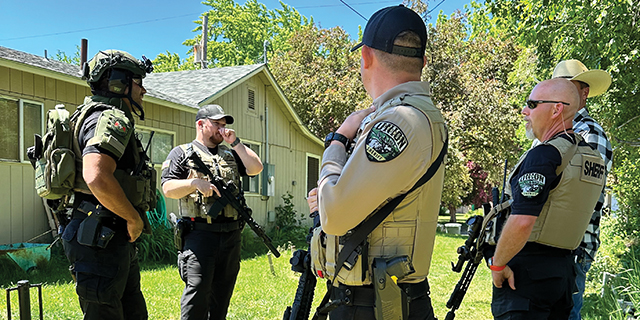EAGLE NEST GENERATES EXCITEMENT AT WALLOWA LAKE
Published 12:00 am Friday, May 30, 2003

- The eagles and nest are easily seen from the highway at the lake's south end. ().
By Gary Fletcher
Observer Staff Writer
WALLOWA LAKE A pair of bald eagles has built a nest and is raising young at Wallowa Lake, reportedly for the first time since the 1940s.
Authorities charged with protecting them from the top predator man are working to enhance people’s viewing opportunities.
Bird watching should be additionally intriguing because ospreys vacated a nearby nest when the bigger, dominant eagles began building their own.
The ospreys moved to a tree on the west moraine, said Mark Henjum, Oregon Department of Fish and Wildlife regional wildlife biologist.
Eagles occasionally steal fish from ospreys.
The eagles did not use the osprey nest that has been there for several years. The cooperative building of a nest is thought to be an important part of the courting process and social activities of eagles.
andamp;quot;We are pretty excited about it. You couldn’t have a better backdrop for viewing Mount Chief Joseph, at the gem of all Oregon state parks,andamp;quot; Henjum said.
andamp;quot;I’m really impressed with the Wallowa Lake State Park staff. They have a lot of other things on their plate, yet they really stepped up to help protect these birds that are listed as threatened in Oregon by both the state and federal government. And they are simultaneously working toward maximizing people’s viewing opportunities of the national bird.andamp;quot;
Wes Jones of the park’s Visitors Service Team has been working with Henjum to devise a way to protect the threatened birds from human activity that may drive them off, yet also give the public the greatest viewing opportunities.
People are asked not to approach the tree. A better elevated viewing site at a nearby turnout on the highway at the lake’s south end will be enhanced.
A camp host is expected to start manning the turnout Monday for four hours a day, five days per week, Jones said. Interpretive information about bald eagles will be provided.
The eagles and nest are easily seen from the turnout, but Henjum is seeking a donation to provide a closeup view of the eaglets, thought to have hatched in May. The eaglets won’t get their distinctive white head for about five years when they mature and are ready to breed and hopefully nest at the lake.
The eaglets will leave the nest about the third week of June, Henjum estimates. They typically hang around the area. Sometimes the parents continue to feed them in places other than the nest.
There are nine known historic nests being monitored annually in Wallowa County, but this is one of only two known to be occupied. A lower valley nest has been occupied since 1999. The other was discovered in 1993 along the Wallowa River below Joseph. However, it was wind damaged, so the pair at the lake may have moved from there.
What adds to the excitement is that the comeback of bald eagles has been markedly slower in Northeast Oregon compared to the rest of the state.
The number of breeding pairs in Oregon has doubled every 10 years since the mid-1970s, according to a 25-year study by biologists from the Oregon Cooperative Fish and Wildlife Unit at Oregon State University.
There are only four known nesting pairs in Union and Baker counties. In 1984 a pair was spotted at Unity Reservoir, then in 1990 a pair appeared at Phillips Reservoir, then at John Day in 1991, then in Wallowa County in 1993, Henjum said.
Eagles have been wintering in Wallowa County and Snake River reservoirs typically from late November through March to May in recent years, but those are birds that migrate from Yellowstone and areas to the north. The number that migrate depends on winter weather and food supply. It is thought that eagles were common along the Snake River, Henjum said.
They typically utilize corridors of Grande Ronde and Wallowa rivers until the ground squirrels emerge in the spring. Placentas at cattle calving sites are also popular. Their winter feed is typically fish and carrion.
Migrating bald eagles congregate at communal roosting sites in small areas to spend winter nights. As many as 100 have been observed at one Wallowa County site, Henjum said.
Protection of communal roosting sites has also been rewarding, he said. He works as a consultant in cooperation with Oregon Department of Forestry, which is in charge of protection with landowners.
andamp;quot;We have had outstanding cooperation with landowners who have roost sites on their property,andamp;quot; Henjum said. Property owners have participated in measures to protect these roosting sites in big old trees with open limbs, in particular places that the majestic birds seem to like.
andamp;quot;It’s pretty unique. Some people take pride in protecting the birds and their habitat,andamp;quot; Henjum said of landowners who are careful to do their thinning and silviculture work when the eagles are gone.
Likewise, the Oregon Forestry Department makes a conscious effort to work with landowners, allowing them to conduct forestry operations on their land, with a minimum protection measures. andamp;quot;So far we still seem to have birds using these sites since the early ’90s,andamp;quot; Henjum said.
The peregrine falcon reintroduction program has also been successful in Oregon, Henjum said. They have occupied a couple of sites along the Columbia River, and there is now a site in Wallowa County as well as one in Union County. andamp;quot;This has taken a long time to happen, and we’re pretty excited about it,andamp;quot; Henjum said.
Winter and spring are the best times to view bald eagles. To learn where to view eagles, access weekly recreation reports at local ODFW offices, or on the Web at www.dfw.state.or.us.





